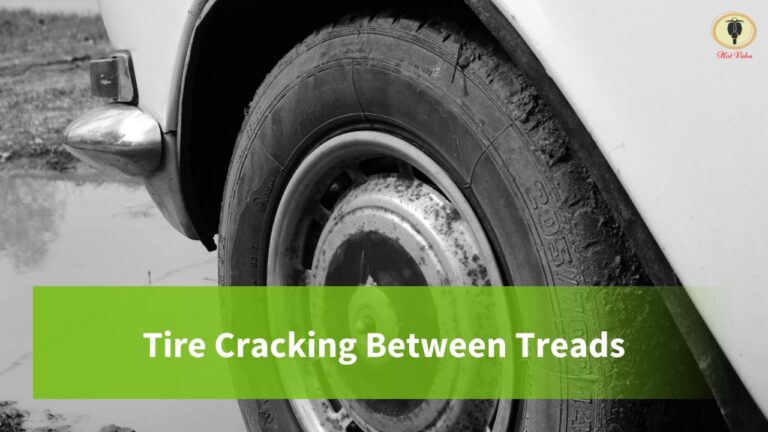Are you a little worried about the cracks that you see in between your tire treads? If you are, you’ve come to the right place. We will explore what causes cracks on your tires, how to prevent them, and discuss the dangers associated with them.
Cracks between the treads of our tires are indeed not pleasant to our eyes. If you are very particular with the aesthetic feature of your tires, you might want to replace the cracking tire to get rid of the problem.
However, superficial cracks on your tire may not necessarily require a replacement. Read on to understand more about tire cracks and how to deal with them.
What Causes Cracks Between Tire Treads
The cracks in your tires, or what some people call “dry rot,” could be due to age, UV rays, extreme cold, manufacturing defects, improper tire pressure, exposure to chemicals or oils, and water.
Natural Aging
If the tire is about 5 to 6 years old, you would likely start to see cracks building up from the sidewall towards the tread area. This phenomenon is typical as the quality of the rubber compound and its components will start to deteriorate.
UV Light
The tire of your vehicle contains some chemicals. The exposure of a tire to direct sunlight could break down these chemicals, causing the tire to dry rot or crack.
It is hard to keep your tires off from the sunlight, especially if you are constantly out on the road. Where you park your vehicle matters, so as much as possible, you should choose where you park your car when you are out.
Extreme Cold
Tire cracking due to extreme cold can only happen for non-winter tires you will use for winter. Some car owners will decide to keep their summer tires for the winter season.
Using a non-winter tire that could not withstand cold temperatures would result in irreversible cracking.
Manufacturing Defects
This scenario rarely happens, but it does happen sometimes. If the quality of your tire is not very good, this may occur. Low-quality materials used to produce the tire could be a reason to crack.
A tire could be built with outdated rubber that causes cracking. Most tires come with materials and a craftmanship warranty. Manufacturing defects may qualify for a replacement. Check with your tire dealer to confirm warranty claims.
Improper Tire Pressure
Improper pressure on your tire may cause your tire to have some cracks between treads. Online forums indicate that under or overinflation of tires can lead to tire cracks.
This scenario is likely to happen if your tire is also getting old. Overinflating a tire will force the rubber to stretch, causing it to crack.
Similarly, if your tires are under-inflated, they may stretch when you hit bumps or if you take a rough road, resulting in the same problem.
Exposure to Chemicals or Oils
Tires exposure to gasoline, oil, or any highly-acidic chemicals (could be some cleaning chemicals) can cause it to crack. Some cleaning agents may include a high level of acidity that can cause the tire to rot.
Long Disuse Period
The rubber in your tire needs some exercise to avoid cracks. Long-term disuse of a tire can create cracking issues as the antioxidants and other chemicals within the tire are not evenly distributed.
Prolonged Exposure to Water
Although this rarely happens, prolonged tire exposure to water can cause it to be elastic, leading to degradation and cracking.
How Much Tire Cracking is Too Much
As your tires get older, you may notice some cracks appearing between their treads. The question is, how much cracking is too much?
Tire cracking between treads does not always mean that you need to replace the tire. However, it is something that needs serious attention. You need to check the condition of the cracking carefully. See if it extends deep into the surface.
If the cracks extend deep into the surface, it means that the rubber compound is no longer reliable. Therefore, you should consider replacing the tire. On the other hand, if the cracks between the treads are relatively small, your tire can still serve miles.
However, I suggest that you check how long you have been using the tire as it may need a replacement already due to its age. Tires are usually suitable for use between 5 to 6 years.
Are Cracks in Tire Treads Dangerous
As discussed in the previous section, cracks in between treads of the tire can be dangerous if it is deep. As I suggested, you need to assess the actual condition of the cracks carefully. If you are not confident with your assessment, your trusted tire professional can inspect your tires and give you the best advice.
There have been cases where a tire would need replacement due to serious tread cracks, even if the tread depth still looks fine. Whether we like it or not, there are some low-quality tires out there that can potentially fail after driving a few miles.
How to Prevent Tire Cracking
I always believe in the phrase “prevention is better than cure” by the Dutch philosopher Desiderius Erasmus. If we take good care or do proper tire maintenance, we can avoid common issues like the case of tire cracking.
Below are some tips on how to avoid tire cracking:
Be Careful with Using Tire Cleaners
Alcohol and petroleum-based tire cleaners can cause dryness on the rubber surface, causing it to crack. Alcohol and petroleum can also potentially wash away the protective antioxidants and antiozonants in the tire, resulting in premature degradation.
I suggest using mild soap and water when cleaning your tires. It is the safest way to go to avoid cracks from showing.
Choose Where You Park
Part of proper vehicle care is a good parking space. If you park your car in an open area that is susceptible to different weather conditions, such as extreme heat or direct exposure to the sun, it would be likely that your tire will have cracking problems. You’ve already learned how these elements can cause your tire to crack.
Exercise Your Tires
If you do not often travel or drive around town, tire cracking can occur because your tire needs exercise to perform at its best. The antioxidants and antiozonants components must move closer to the tire’s surface. Driving it at least once every couple of months will do the trick.
Inflate Your Tires Properly
Always follow the manufacturer’s recommended tire air pressure. Underinflating or overinflating your tires can cause multiple potential issues, including uneven tread wear, and of course, cracking.
Avoid Chemical Contacts
We sometimes carelessly spill some chemicals in our garage. As we get home and park our car, it is essential to check if the tires are not getting in contact with harsh chemicals that may cause the tire to degrade and crack.
Carefully Choose Your Tire Brand
I always include this in the articles that I write when I can. I have nothing against cheap tires in the market. However, it would be best to be careful when choosing the tire to install on your vehicle. Get the one that many car owners trusts.
It does not need to be expensive, but it needs to have a solid reputation for good quality. A tire with poor rubber formulation can potentially degrade quicker.
Can You Fix Small Cracks Between Tire Treads?
There is always a way to fix things out. In most cases, cracks between the tire tread do not reach the internal part of the tire. Otherwise, you will face a slow leak issue. If this is the case, you can use a sealant to fix the tire internally. However, I would suggest that you replace the tire if the cracks are as severe as this.
You can also possibly fix external cracks using protectants, an external version of a sealant. We are not going into detail on the process of doing it, but of course, it involves thoroughly cleaning the tires and applying the protectant as instructed. If you want to see how to do it, I recommend this article.
When applying a tire protectant is essential to ensure that the protectant gets inside the cracks and that all areas are covered.
Conclusion
There you have it! I hope this article gives you some relevant insights about tire cracking in between treads.
To quickly recap, tire cracking can happen due to multiple reasons, including exposure to UV rays, temperature changes, material quality, improper tire pressure, a prolonged period of disuse, and exposure to harsh chemicals.
To prevent your tires from cracking, you must ensure to avoid using harsh chemicals on your tire, inflate your tires properly, and store or park your vehicle in an area that is not exposed to changing weather conditions.
You must also ensure that you drive your car now and then to exercise the tires.
Cracked tires may not always require replacements, but careful assessment is required. If you think the cracks are severe, get the opinion of a tire professional.

